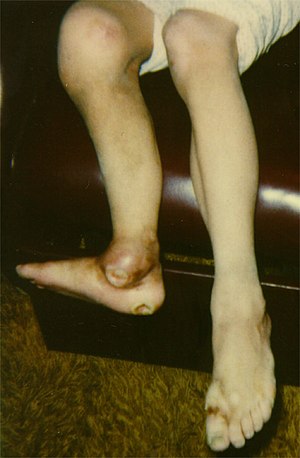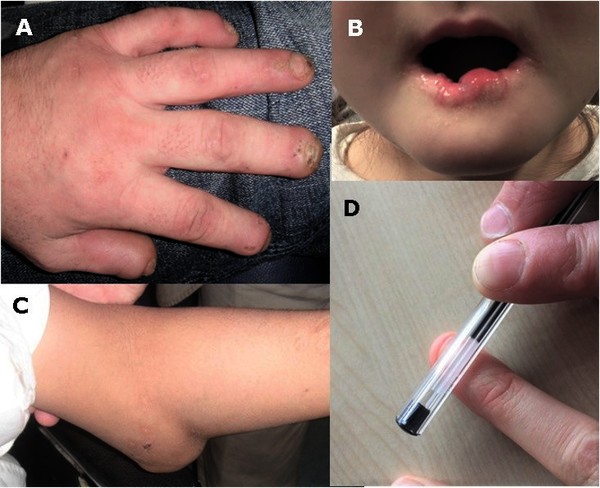CIPA (Congenital Insensitivity to Pain with Anhidrosis) is an extremely rare genetic disorder characterized by two primary features: the inability to feel pain and changes in temperature, and the reduced or absent ability to sweat (anhidrosis). This disorder is also known as Hereditary Sensory and Autonomic Neuropathy Type IV (HSAN IV). Let’s use a popular Hindi movie dialogue to help explain CIPA:
Movie Dialogue: "Mard ko dard nahi hota."
In Hindi cinema, there’s a famous dialogue, “Mard ko dard nahi hota,” which translates to “Men don’t feel pain.” This dialogue is often used in action-packed scenes where the hero of the movie displays bravery and toughness in the face of danger. It implies that a real man is so strong that he doesn’t experience pain.
Now, let’s relate this dialogue to CIPA:
CIPA is a condition where individuals truly do not feel pain (Patients ko Dard nhi hota), unlike the movie dialogue where it’s used metaphorically. People with CIPA lack the ability to perceive pain, so they may not react to injuries or discomfort the way most people do. While the movie dialogue celebrates bravery, in the context of CIPA, it highlights a real medical condition where the absence of pain perception can be a significant challenge.
In reality, not feeling pain can be dangerous. Pain serves as a protective mechanism that alerts us to potential harm or injuries. Without the ability to feel pain, individuals with CIPA are at a higher risk of unintentional self-injury and may not notice when they are hurt. For example, they might accidentally bite their tongues, lips, or fingers without realizing it, and this can lead to severe injuries. Some might even experience spontaneous amputation of affected body parts due to self-inflicted harm.
So, while the movie dialogue suggests that being impervious to pain is a symbol of strength, in the case of CIPA, it underscores the challenges and risks associated with not being able to feel pain, which is a medical condition rather than a heroic attribute.
Introduction to Congenital Insensitivity to Pain with Anhidrosis (CIPA)
Understanding CIPA: What Is It?
CIPA, or Congenital Insensitivity to Pain with Anhidrosis, is a rare genetic disorder characterized by two hallmark features: the inability to perceive pain and temperature, along with diminished or absent sweating, a condition known as anhidrosis. This disorder is also referred to as Hereditary Sensory and Autonomic Neuropathy Type IV (HSAN IV). In this article, we will delve deep into the world of CIPA, exploring its causes, symptoms, and the challenges faced by those living with this condition.
The Early Onset of CIPA
The signs and symptoms of CIPA manifest early in life, typically at birth or during infancy. However, with proper medical care and attention, individuals affected by CIPA can lead relatively long lives, even into adulthood.
The Complexities of Living with CIPA
The Consequences of Insensitivity: Frequent Injuries
One of the most striking aspects of CIPA is the inability to feel pain or changes in temperature. Paradoxically, this leads to a higher propensity for severe injuries. Individuals with CIPA often engage in unintentional self-injury, commonly biting their tongues, lips, or fingers. In some cases, this self-inflicted harm can even lead to spontaneous amputation of the affected body parts. Moreover, CIPA patients exhibit delayed wound healing, making them susceptible to chronic skin and bone injuries. Repeated trauma may result in conditions such as osteomyelitis or Charcot joints, characterized by the destruction of bones and surrounding tissues.
| Congenital insensitivity to pain with anhidrosis | |
|---|---|
 | |
| Charcot joints are shown in this boy with CIPA. | |
| Causes | Genetic mutations |
The Cooling Mechanism: Sweating and CIPA
Sweating plays a crucial role in regulating body temperature. However, in those with CIPA, anhidrosis disrupts this natural cooling process, causing recurrent and dangerously high fevers, medically termed hyperpyrexia. High temperatures can also trigger febrile seizures, posing additional health risks to individuals with CIPA.
Beyond the Basics: Additional Symptoms
In addition to the primary characteristics, CIPA can present with various other signs and symptoms. Many affected individuals develop thick and leathery skin, a condition known as lichenification, primarily on the palms of their hands. Misshapen fingernails or toenails are also common. Some may experience patches of hair loss on their scalps, referred to as hypotrichosis. Behavioral issues are prevalent, with approximately half of CIPA patients displaying signs of hyperactivity or emotional instability. Moreover, many individuals with CIPA may face intellectual disabilities. While some may exhibit weak muscle tone, this tends to improve as they grow older.

Understanding the Rarity and Causes of CIPA
The Rarity of CIPA
CIPA is an exceedingly rare condition, and its prevalence remains unknown. This rarity makes it crucial to raise awareness and understanding of the disorder.
The Genetic Basis: Mutations in the NTRK1 Gene
CIPA is primarily caused by mutations in the NTRK1 gene. This gene provides instructions for the creation of a receptor protein that binds to another protein called NGFβ. The NTRK1 receptor is particularly crucial for the survival of nerve cells, also known as neurons.
The Role of NTRK1 Receptor in Sensory Neurons
Sensory neurons, which are responsible for transmitting pain, temperature, and touch sensations, prominently feature the NTRK1 receptor. When NGFβ binds to this receptor, it initiates signals within the cell, promoting growth, division, and cell survival. Mutations in the NTRK1 gene result in a non-functional receptor that cannot transmit these vital signals. Consequently, sensory neurons die through a process known as apoptosis. This loss of sensory neurons is the primary cause of the inability to perceive pain experienced by individuals with CIPA. Additionally, the lack of functional nerves leading to sweat glands contributes to the development of anhidrosis in affected individuals.
Inheritance Patterns of CIPA
Autosomal Recessive Inheritance
CIPA follows an autosomal recessive inheritance pattern. This means that both copies of the NTRK1 gene in each cell must have mutations for an individual to develop the condition. Parents of an individual with CIPA each carry one copy of the mutated gene, but they typically do not exhibit any signs or symptoms of the disorder.
Alternative Names for CIPA
CIPA by Any Other Name
CIPA is known by several alternative names, reflecting its various aspects and characteristics:
- Hereditary Insensitivity to Pain with Anhidrosis
- Hereditary Sensory and Autonomic Neuropathy Type IV
- Hereditary Sensory and Autonomic Neuropathy, Type 4
- HSAN Type IV
- HSAN4
Living with CIPA
Living with CIPA presents significant challenges and requires specialized care. Given the inability to perceive pain and temperature, individuals with CIPA are prone to accidents and injuries that may go unnoticed. Therefore, early diagnosis and vigilant medical attention are crucial for managing this condition effectively.
Medical Care
Medical care for individuals with CIPA often involves:
Pain Management
While individuals with CIPA do not experience pain in the same way as others, it is essential to address any injuries promptly to prevent complications. Pain management in CIPA patients typically focuses on treating injuries, preventing infections, and managing pain-related complications.
Temperature Regulation
Since individuals with CIPA cannot regulate their body temperature through sweating, it is essential to monitor and manage their body temperature carefully. This may involve cooling techniques and medications to prevent hyperpyrexia and associated seizures.
Skin and Wound Care
Due to the slow healing of skin and bone injuries, meticulous care of wounds and skin lesions is crucial. This includes the prevention of infections, timely wound dressings, and monitoring for any signs of osteomyelitis.
Psychological Support
Living with CIPA can be emotionally challenging, particularly for children and adolescents who may exhibit hyperactivity and emotional instability. Psychosocial support, including therapy and counseling, can help individuals and their families cope with the emotional aspects of this condition.
Education and Adaptation
Many individuals with CIPA have intellectual disabilities, and tailored educational plans are often necessary. As they grow older, their muscle strength and tone may improve, allowing them to adapt to their condition and lead more fulfilling lives.
Current Research and Future Prospects
Ongoing research in the field of genetics and neurology continues to shed light on CIPA. Scientists are exploring potential treatments and interventions that could improve the quality of life for individuals with this condition. While there is no cure for CIPA at present, advancements in medical science may offer hope for the future
Conclusion: Navigating Life with CIPA
In conclusion, Congenital Insensitivity to Pain with Anhidrosis (CIPA) is a rare and complex genetic disorder that profoundly impacts the lives of those affected. With a lack of pain and temperature sensitivity, along with the challenges posed by anhidrosis, individuals with CIPA face unique hurdles. Understanding the genetic basis and inheritance pattern of CIPA is crucial for both medical professionals and affected individuals and their families. Increased awareness and research are essential steps toward improving the lives of those living with this condition.
Refrences
- Indo Y, Tsuruta M, Hayashida Y, Karim MA, Ohta K, Kawano T, Mitsubuchi H, Tonoki H, Awaya Y, Matsuda I. Mutations in the TRKA/NGF receptor gene in patients with congenital insensitivity to pain with anhidrosis. Nat Genet. 1996 Aug;13(4):485-8. doi: 10.1038/ng0896-485. Citation on PubMed
- Indo Y. Molecular basis of congenital insensitivity to pain with anhidrosis (CIPA): mutations and polymorphisms in TRKA (NTRK1) gene encoding the receptor tyrosine kinase for nerve growth factor. Hum Mutat. 2001 Dec;18(6):462-71. doi: 10.1002/humu.1224. Citation on PubMed
- Kaplan DR, Miller FD. Neurotrophin signal transduction in the nervous system. Curr Opin Neurobiol. 2000 Jun;10(3):381-91. doi: 10.1016/s0959-4388(00)00092-1. Citation on PubMed
- Miranda C, Di Virgilio M, Selleri S, Zanotti G, Pagliardini S, Pierotti MA, Greco A. Novel pathogenic mechanisms of congenital insensitivity to pain with anhidrosis genetic disorder unveiled by functional analysis of neurotrophic tyrosine receptor kinase type 1/nerve growth factor receptor mutations. J Biol Chem. 2002 Feb 22;277(8):6455-62. doi: 10.1074/jbc.M110016200. Epub 2001 Nov 21. Citation on PubMed
- Verhoeven K, Timmerman V, Mauko B, Pieber TR, De Jonghe P, Auer-Grumbach M. Recent advances in hereditary sensory and autonomic neuropathies. Curr Opin Neurol. 2006 Oct;19(5):474-80. doi: 10.1097/01.wco.0000245370.82317.f6. Citation on PubMed
- Verpoorten N, De Jonghe P, Timmerman V. Disease mechanisms in hereditary sensory and autonomic neuropathies. Neurobiol Dis. 2006 Feb;21(2):247-55. doi: 10.1016/j.nbd.2005.08.004. Epub 2005 Sep 23. Citation on PubMed
Nice article